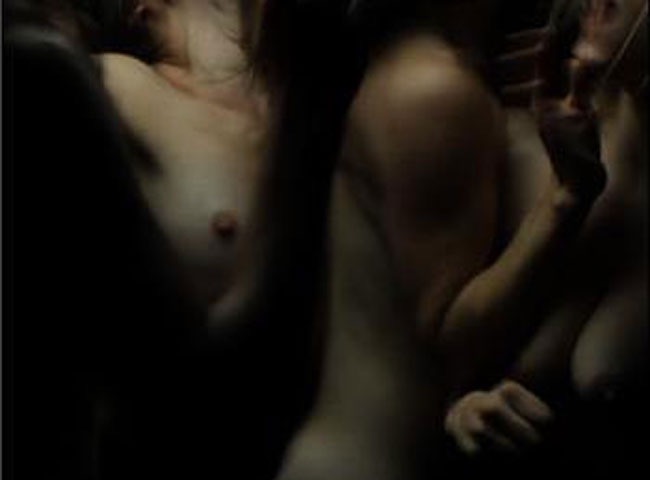Meurtrière
-
Réalisé par Philippe Grandrieux • Écrit par Philippe Grandrieux
-
France • 2015 • 60 minutes • HD • Couleur
- Réalisation :
Philippe Grandrieux - Écriture :
Philippe Grandrieux - Image :
Philippe Grandrieux - Son :
Philippe Grandrieux - Montage :
Philippe Grandrieux
- Production (structure) :
Epileptic Film - Participation :
Image/mouvement - Aide au développement et à la post-production - Ayant droit :
Epileptic Film
- N° ISAN :
non renseigné
Résumé
White Epilepsy (FID 2012), on s’en souvient, évoquait la rencontre entre un homme et une femme, ou plutôt entre deux figures archaïques surgies du fond de la nuit et des images. Meutrière est le deuxième mouvement de cette trilogie dont "le sujet", nous dit le réalisateur, "est l’inquiétude". Quelle inquiétude sinon cette trépidation, cet émoi qui nous constitue et qui se trouve à la source en nous de notre fabrique d’image. Philippe Grandrieux poursuit ainsi depuis Sombre son exploration de nos agitations les plus intimes. Ici les corps, pris à nouveau dans leur nudité font quatuor, et sont saisis dans un travail de glorification de la figuration autant que de défiguration, chahut inscrit au cœur même de l’image. Ce qui se devine comme buste, jambe, ou bras entremêlés, offre la matière d’un ballet de fragments devenus chairs malaxées, malmenées, écorchées par le seul travail de la lumière, des ombres et du cadre à la verticalité assumée. Corps dont le ralenti dicte le mouvement même du film : une métamorphose continue sans répit ni repos de l’image, de ses fulgurations et ses déchirures muettes. Une peinture des corps menée aux limites du cinéma – l’objet du meurtre ? – qu’accompagne le son, lancinante basse continue comme cri intérieur, une sorte de contrepoint à la plasticité de l’image et de ses mouvements sans cesse reconduits. (Nicolas Féodoroff, FIDMarseille 2015)
White Epilepsy (FID 2012), as we can remember, evoked the meeting of a man and a woman, or rather two archaic figures emerging from the depths of the night and images. Arrow slit is the second act of this trilogy whose "subject" as the filmmaker says "is anxiety". What anxiety if not this throb, this agitation that makes us what we are and which lies at the core of our being, of our crafting of images. Philippe Grandrieux thus, since Sombre, pursues his exploration of our most intimate emotions. Here the bodies, taken once again in their nudity, become a quartet and are thus held in the working of a glorification of their embodiment just as much as their disembodiment, disruptively inscribed in the very heart of the image. That which can be seen as a torso, leg or arm intertwined, offers the material for a ballet of fragments that have become flesh kneaded, manhandled, burnt only by the work with the light, the shadows and the frame of the assumed verticality. Bodies whose slowing down dictates the very movement of the film : a continuous metamorphosis, relentless and without resting the image, its fulgurations and speechless tearing. A painting of bodies brought to the very limits of cinema – the object of murder? – which the sound, a piercing continuous bass like an inner scream, accompanies as a form of counterweight to the plasticity of the image and its unceasingly repeated movements. (Nicolas Féodoroff, FIDMarseille 2015)
Collection
Mot(s)-clé(s) thématique(s)
Sélections et distinctions
- 2016 • Jeonju International Film Festival • Jeonju (Corée du Sud) • Sélection
- 2015 • Zinebi - Festival international du film documentaire et du court métrage de Bilbao • Bilbao (Espagne) • Sélection
- 2015 • Sevilla Festival de Cine Europeo • Seville (Espagne) • Sélection
- 2015 • FNC - Festival du Nouveau Cinéma • Montréal (Canada) • Sélection FNC Lab Films - Prix long-métrage ex-æquo
- 2015 • FIDMarseille - Festival International de Cinéma de Marseille • Marseille (France) • Compétition internationale
Comment avoir accès au film ?
-
Édition DVD
- Il n'existe pas d'édition DVD à notre connaissance
-
Accès VOD
- Il n'existe pas d'accès en VOD à notre connaissance
- Distribution
- Aide sur les moyens d'accéder à un film
